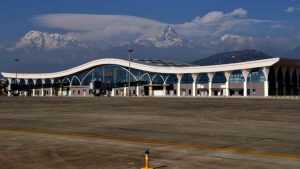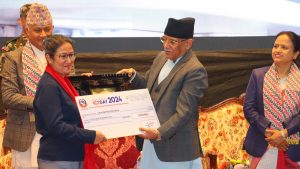
SJVN Optimistic About Mutual Benefits from Arun III and Upper Arun Hydropower Projects

India’s SJVN Limited, the entity behind the Arun III and Upper Arun hydropower projects in Nepal, has asserted that both countries stand to gain equally from the operationalization of these ventures. The 900 MW Arun III and the 1,061 MW Upper Arun projects, currently under construction, are expected to meet Nepal’s immediate electricity demand while providing surplus power for export to India and Bangladesh.
Manoj Kumar, the Executive Director of the Nathpa Jhakri Hydro Power Station in Himachal Pradesh, India, emphasized the potential benefits during an on-site inspection of India’s largest 1,500 MW Nathpa Jhakri Hydro Power Station. Kumar stated that once operational, the projects would meet Nepal’s electricity needs, allowing the nation to sell excess power to neighboring countries.
While acknowledging the positive prospects of the projects, Kumar also highlighted the need to address land compensation issues promptly, emphasizing the importance of resolving these challenges for seamless construction progress.
A delegation from Nepal, representing various political parties, participated in the on-site inspection during a study visit to India’s hydropower projects. The delegation included members from Nepali Congress, CPN UML, CPN Maoist Center, CPN Samajwadi, JSP, and Janmat. Executive Director Manoj Kumar honored the leaders of the delegation for their visit.
Anil Rungata and Nayansingh Mahar from Nepali Congress, Sunita Baral and Surya Pathak from CPN UML, Renu Chand and Ajayshankar Nair from CPN Maoist Center, Goma Bista from CPN Samajwadi, Ram Ashish Yadav from JSP and Deepak Shah from Janmat participated in the team.
India has demonstrated success in constructing six hydropower projects along the Sutlej River. Projects such as the Karcham Wangtoo Hydroelectric Plant (1200 MW), Nathpa Jhakri Hydro Power Station (1500 MW), Rampur HPS (412 MW), and Koldam Hydropower Station (800 MW) are operational, while others, including Luhri Hydropower Station (210 MW) and Sunni Dam Hydro Electric Project (382 MW), are expected to be operational within a year.
Nepal, with its abundant water resources, is seen as having significant potential in hydropower generation. Energy experts believe that harnessing the power of the country’s rivers could lead to prosperity, with the possibility of selling over 50,000 megawatts of electricity. Currently, under the Nepal Electricity Authority, existing projects like the 456 MW Tamakosi Hydroelectric Project, 106 MW Kulekhani, 12 MW Budhi Gandaki Hydro, and 144 MW Kaligandaki Hydroelectric Project contribute around 2300 MW in the rainy season and 1200 to 1300 MW in winter.
Hydropower projects like the 1061 MW Upper Arun, 811 MW Uttar Ganga, 635 MW Dudhkoshi, and 210 MW Chayanpur Seti, proposed by the Nepal Electricity Authority, are seen as critical steps to achieving self-reliance on electricity and propelling the nation towards prosperity. Bhutan’s success in selling electricity to India, contributing to increased GDP, serves as an encouraging model for regional collaboration and economic growth.














Comments